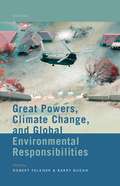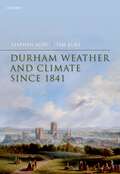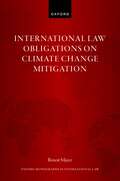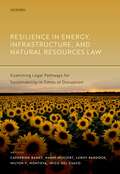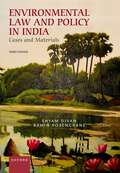- Table View
- List View
From Ideas to Action: Governance Paths to Net Zero
by Janis SarraThis book offers a guide, for companies, pension funds, asset managers, and other institutional investors, on how to commence the legal, governance, and financial strategies needed for effective climate mitigation and adaptation, and to help distribute the economic benefits of these actions to their stakeholders. It takes the reader from ideas to action, from first steps to a more meaningful contribution to the move towards a net zero carbon world. It can serve as a helpful guide to everyone implicated in a corporation's activities - employees, pensioners, consumers, banks and other lenders, policymakers, and community members. It offers insights into what we should be expecting, and asking, of these fiduciaries who have taken responsibility for effectively managing our savings, our retirement funds, our investments, and our tax dollars.
From Ideas to Action: Governance Paths to Net Zero
by Janis SarraThis book offers a guide, for companies, pension funds, asset managers, and other institutional investors, on how to commence the legal, governance, and financial strategies needed for effective climate mitigation and adaptation, and to help distribute the economic benefits of these actions to their stakeholders. It takes the reader from ideas to action, from first steps to a more meaningful contribution to the move towards a net zero carbon world. It can serve as a helpful guide to everyone implicated in a corporation's activities - employees, pensioners, consumers, banks and other lenders, policymakers, and community members. It offers insights into what we should be expecting, and asking, of these fiduciaries who have taken responsibility for effectively managing our savings, our retirement funds, our investments, and our tax dollars.
Global Justice and the Biodiversity Crisis: Conservation in a World of Inequality
by Chris ArmstrongThe world is in the midst of a biodiversity crisis, which existing conservation policies have failed to arrest. Policymakers, academics, and the general public are coming to recognise that much more ambitious conservation policies are in order. But biodiversity conservation raises major issues of global justice - even if the connection between conservation and global justice is too seldom made. The lion's share of conservation funding is spent in the global North, despite the fact that most biodiversity exists in the global South, and local people can often scarcely afford to make sacrifices in the interests of biodiversity conservation. Many responses to the biodiversity crisis threaten to exacerbate existing global injustices, to lock people into poverty, and to exploit the world's poor. At the extreme, policies aimed at protecting biodiversity have also been associated with exclusion, dispossession, and violence. The challenge this book grapples with is how biodiversity might be conserved without producing global injustice. It distinguishes policies which are likely to exacerbate global injustice, and policies which promise to reduce them. The struggle to formulate and implement just conservation policies is vital to our planet's future.
Global Justice and the Biodiversity Crisis: Conservation in a World of Inequality
by Chris ArmstrongThe world is in the midst of a biodiversity crisis, which existing conservation policies have failed to arrest. Policymakers, academics, and the general public are coming to recognise that much more ambitious conservation policies are in order. But biodiversity conservation raises major issues of global justice - even if the connection between conservation and global justice is too seldom made. The lion's share of conservation funding is spent in the global North, despite the fact that most biodiversity exists in the global South, and local people can often scarcely afford to make sacrifices in the interests of biodiversity conservation. Many responses to the biodiversity crisis threaten to exacerbate existing global injustices, to lock people into poverty, and to exploit the world's poor. At the extreme, policies aimed at protecting biodiversity have also been associated with exclusion, dispossession, and violence. The challenge this book grapples with is how biodiversity might be conserved without producing global injustice. It distinguishes policies which are likely to exacerbate global injustice, and policies which promise to reduce them. The struggle to formulate and implement just conservation policies is vital to our planet's future.
Energy Justice and Energy Law
Energy justice has emerged over the last decade as a matter of vital concern in energy law, which can be seen in the attention directed to energy poverty, and the United Nations Sustainable Development Goals. There are energy justice concerns in areas of law as diverse as human rights, consumer protection, international law and trade, and in many forms of regional and national energy law and regulation. This edited collection explores in detail at four kinds of energy justice. The first, distributive justice, relates to the equitable distribution of the benefits and burdens of energy activities, which is challenged by the existence of people suffering from energy poverty. Secondly, procedural (or participation) justice consists of the right of all communities to participate in decision-making regarding energy projects and policies that affect them. This dimension of energy justice often includes procedural rights to information and access to courts. Under the concept of reparation (or restorative) justice, the book looks at even-handed enforcement of energy statutes and regulations, as well as access to remedies when legal rights are violated. Finally, the collection addresses social justice, with the recognition that energy injustice cannot be separated from other social ills, such as poverty and subordination based on race, gender, or indigeneity. These issues feed into a wider conversation about how we achieve a 'just' energy transition, as the world confronts the urgent challenges of climate change.
Energy Justice and Energy Law
by Íñigo Del Guayo, Lee Godden, Donald N. Zillman, Milton F. Montoya, José Juan GonzálezEnergy justice has emerged over the last decade as a matter of vital concern in energy law, which can be seen in the attention directed to energy poverty, and the United Nations Sustainable Development Goals. There are energy justice concerns in areas of law as diverse as human rights, consumer protection, international law and trade, and in many forms of regional and national energy law and regulation. This edited collection explores in detail at four kinds of energy justice. The first, distributive justice, relates to the equitable distribution of the benefits and burdens of energy activities, which is challenged by the existence of people suffering from energy poverty. Secondly, procedural (or participation) justice consists of the right of all communities to participate in decision-making regarding energy projects and policies that affect them. This dimension of energy justice often includes procedural rights to information and access to courts. Under the concept of reparation (or restorative) justice, the book looks at even-handed enforcement of energy statutes and regulations, as well as access to remedies when legal rights are violated. Finally, the collection addresses social justice, with the recognition that energy injustice cannot be separated from other social ills, such as poverty and subordination based on race, gender, or indigeneity. These issues feed into a wider conversation about how we achieve a 'just' energy transition, as the world confronts the urgent challenges of climate change.
Fresh Water in International Law
by Laurence Boisson de ChazournesThis book addresses the diverse ways in which international law governs the uses, management, and protection of fresh water. The regulation of fresh water has primarily developed through the conclusion of treaties concerning international watercourses, yet a number of other legal regimes also apply to the governance of fresh water. In particular, there has been an increasing recognition of the importance of fresh water to environmental protection. The development of international human rights law and international humanitarian law has also proven crucial for ensuring the sound and equitable management of this resource. In addition, the economic uses of fresh water feature prominently in the law applicable to watercourses, while water itself has become an important element of the trade and investment regimes. These bodies of rules and principles not only surface in an array of dispute settlement mechanisms, but also stimulate wider trends of institutionalization. Since the publication of the first edition of this volume in 2013, water has continued to be at the forefront of the international agenda, and the adoption of the UN Sustainable Development Goals constitutes a milestone around which various public and private initiatives have been launched. This book presents and appraises these important developments as part of its comprehensive analysis of the origin and scope of the various areas of international law as they apply to fresh water. It demonstrates how these areas connect and adapt to one another, forming an integrated body of international principles.
Fresh Water in International Law
by Laurence Boisson de ChazournesThis book addresses the diverse ways in which international law governs the uses, management, and protection of fresh water. The regulation of fresh water has primarily developed through the conclusion of treaties concerning international watercourses, yet a number of other legal regimes also apply to the governance of fresh water. In particular, there has been an increasing recognition of the importance of fresh water to environmental protection. The development of international human rights law and international humanitarian law has also proven crucial for ensuring the sound and equitable management of this resource. In addition, the economic uses of fresh water feature prominently in the law applicable to watercourses, while water itself has become an important element of the trade and investment regimes. These bodies of rules and principles not only surface in an array of dispute settlement mechanisms, but also stimulate wider trends of institutionalization. Since the publication of the first edition of this volume in 2013, water has continued to be at the forefront of the international agenda, and the adoption of the UN Sustainable Development Goals constitutes a milestone around which various public and private initiatives have been launched. This book presents and appraises these important developments as part of its comprehensive analysis of the origin and scope of the various areas of international law as they apply to fresh water. It demonstrates how these areas connect and adapt to one another, forming an integrated body of international principles.
Great Powers, Climate Change, and Global Environmental Responsibilities
This book is the first of its kind to examine the role of great powers in the international politics of climate change. It develops a novel analytical framework for studying environmental power in international relations, what counts as a great power in the environmental field, and what their special environmental responsibilities are. In doing so, the book connects International Relations (IR) debates on power inequality, great powers and great power management, with global environmental politics (GEP) scholarship. The book brings together leading scholars in IR and GEP whose contributions focus on major environmental powers (United States, China, European Union, India, Brazil, Russia) and international institutions and issue areas (UN Security Council, multilateral environmental agreements, international climate leadership, coal politics). The contributors to this volume examine how individual great powers have responded to the global climate challenge and whether they have accepted a special responsibility for stabilizing the global climate. They place emerging discourses on great power responsibility in the context of wider debates about international environmental leadership and climate change securitization. And they provide new insights into how international power inequality intersects with the global ecological crisis, and what special role great powers could and should play in the international fight against global warming.
Great Powers, Climate Change, and Global Environmental Responsibilities
by Robert FalknerThis book is the first of its kind to examine the role of great powers in the international politics of climate change. It develops a novel analytical framework for studying environmental power in international relations, what counts as a great power in the environmental field, and what their special environmental responsibilities are. In doing so, the book connects International Relations (IR) debates on power inequality, great powers and great power management, with global environmental politics (GEP) scholarship. The book brings together leading scholars in IR and GEP whose contributions focus on major environmental powers (United States, China, European Union, India, Brazil, Russia) and international institutions and issue areas (UN Security Council, multilateral environmental agreements, international climate leadership, coal politics). The contributors to this volume examine how individual great powers have responded to the global climate challenge and whether they have accepted a special responsibility for stabilizing the global climate. They place emerging discourses on great power responsibility in the context of wider debates about international environmental leadership and climate change securitization. And they provide new insights into how international power inequality intersects with the global ecological crisis, and what special role great powers could and should play in the international fight against global warming.
Coral Reefs: A Very Short Introduction (Very Short Introductions)
by Charles SheppardVery Short Introductions: Brilliant, Sharp, Inspiring Coral reefs are among the most beautiful, and most diverse, of ecosystems. Early seafarers were wary of them, naturalists were confused by them, yet many coastal people benefited greatly from these mysterious rocky structures that grew up to the surface of the sea. They have been rich in their supply of food, and they provided a breakwater from storms and high waves to countless coastal communities that developed from their protection. Their scale is enormous and their value high. Found in countless locations around the world, from the Indo-Pacific coral reef province to the Caribbean and Australia, they support both marine and human life. But today coral reefs are in trouble, with many dying or suffering from over-exploitation, pollution, and the warming and acidification of the oceans. Understanding reefs, their conservation and management, is vital, and so is conveying this to authority if we are to preserve these remarkable ecosystems. In this Very Short Introduction Charles Sheppard describes the complex structure and interdependencies of a reef, how reefs have evolved, the diversity of marine life that they support, and their importance to the human population who live beside them. This new edition describes the latest research on the complex symbioses of coral animals with microorganisms. It also highlights the scale of the challenge facing our reefs today, following recent ocean heatwaves - part of wider climate disruption - that killed half the world's reefs, and considers what can be done to preserve these essential and vibrant ecosystems. ABOUT THE SERIES: The Very Short Introductions series from Oxford University Press contains hundreds of titles in almost every subject area. These pocket-sized books are the perfect way to get ahead in a new subject quickly. Our expert authors combine facts, analysis, perspective, new ideas, and enthusiasm to make interesting and challenging topics highly readable.
Coral Reefs: A Very Short Introduction (Very Short Introductions #4)
by Charles SheppardVery Short Introductions: Brilliant, Sharp, Inspiring Coral reefs are among the most beautiful, and most diverse, of ecosystems. Early seafarers were wary of them, naturalists were confused by them, yet many coastal people benefited greatly from these mysterious rocky structures that grew up to the surface of the sea. They have been rich in their supply of food, and they provided a breakwater from storms and high waves to countless coastal communities that developed from their protection. Their scale is enormous and their value high. Found in countless locations around the world, from the Indo-Pacific coral reef province to the Caribbean and Australia, they support both marine and human life. But today coral reefs are in trouble, with many dying or suffering from over-exploitation, pollution, and the warming and acidification of the oceans. Understanding reefs, their conservation and management, is vital, and so is conveying this to authority if we are to preserve these remarkable ecosystems. In this Very Short Introduction Charles Sheppard describes the complex structure and interdependencies of a reef, how reefs have evolved, the diversity of marine life that they support, and their importance to the human population who live beside them. This new edition describes the latest research on the complex symbioses of coral animals with microorganisms. It also highlights the scale of the challenge facing our reefs today, following recent ocean heatwaves - part of wider climate disruption - that killed half the world's reefs, and considers what can be done to preserve these essential and vibrant ecosystems. ABOUT THE SERIES: The Very Short Introductions series from Oxford University Press contains hundreds of titles in almost every subject area. These pocket-sized books are the perfect way to get ahead in a new subject quickly. Our expert authors combine facts, analysis, perspective, new ideas, and enthusiasm to make interesting and challenging topics highly readable.
Durham Weather and Climate since 1841
by Stephen Burt Tim BurtThe British have always been obsessed by the weather. Astronomers at Durham Observatory began weather observations in 1841; weather records continue unbroken to this day, one of the longest continuous series of single-site weather records in Europe. Durham Weather and Climate since 1841 represents the first full publication of this newly digitised record of English weather, which will be of lasting appeal to interested readers and climate researchers alike. The book celebrates 180 years of weather in north-east England by describing how the records were (and are) made and the people who made them, examines monthly and seasonal weather patterns and extremes across two centuries, and considers long-term climate change. Local documentary sources and contemporary photographs bring the statistics to life, from the great flood of 1771 and skating on the frozen River Wear in February 1895 right up to Durham's hottest-ever day in July 2019 and its wettest winter in 2021. Extensive links are provided to full daily weather records back to 1843. This volume is a sister publication to Oxford Weather and Climate since 1767 by the same authors, published by Oxford University Press in 2019.
Guide to the Birds of China
by John MacKinnonChina covers about 7% of the earth's land surface and encompasses a hugely diverse range of habitats. As a result, it boasts a rich and diverse avifauna, including some of the most spectacular and fascinating birds to be found anywhere in the world. Building on the enormous popularity and reputation of the original A Field Guide to the Birds of China (2000), John MacKinnon's fully updated and refreshed work remains a truly comprehensive, taxonomically modern, fully illustrated, and authoritative field guide. 1484 bird species are richly illustrated in 164 annotated colour plates, which are closely integrated with up-to-date colour distribution maps, QR codes providing easy access to birdcalls, IUCN Red List status indicators and new, concise descriptions. These descriptions feature key observations as well as conveying crucial changes to species distributions resulting from climate change and landscape transformation. Guide to the Birds of China will appeal to an international and growing audience of professional and amateur ornithologists and birding enthusiasts, academic researchers and students, wildlife photographers, and conservationists.
International Law Obligations on Climate Change Mitigation (Oxford Monographs in International Law)
by Benoit MayerRecent years have witnessed exciting developments in international negotiations, litigation, and scholarship about climate change, but doctrinal research in the field remains in its infancy. In particular, little is known about how fast states are required to limit and reduce their greenhouse gas emissions. The first part of the book identifies the relevant obligations through an analysis of treaties, custom, and other sources of international law. Beyond express quantified commitments contained for instance in nationally determined contributions, the book sheds light on the existence of general obligations of due diligence. While these general obligations are difficult to interpret, they are often more demanding. The second part explores how these general obligations can be applied objectively, for instance by a court, in concrete cases. Instead of an improbable judicial assessment of a state's requisite level of mitigation action, the book shows the possibility of assessing a state's conduct based on the measures that general mitigation obligations entail. These measures relate to corollary duties of cooperation, vigilance, and consistency. This book presents a first comprehensive doctrinal study of states' obligations on climate change mitigation. It shows that such obligations arise not only from climate treaties, but also from customary international law, unilateral declarations, and, possibly, human rights treaties. It also explores the interactions between these multiple obligations.
International Law Obligations on Climate Change Mitigation (Oxford Monographs in International Law)
by Benoit MayerRecent years have witnessed exciting developments in international negotiations, litigation, and scholarship about climate change, but doctrinal research in the field remains in its infancy. In particular, little is known about how fast states are required to limit and reduce their greenhouse gas emissions. The first part of the book identifies the relevant obligations through an analysis of treaties, custom, and other sources of international law. Beyond express quantified commitments contained for instance in nationally determined contributions, the book sheds light on the existence of general obligations of due diligence. While these general obligations are difficult to interpret, they are often more demanding. The second part explores how these general obligations can be applied objectively, for instance by a court, in concrete cases. Instead of an improbable judicial assessment of a state's requisite level of mitigation action, the book shows the possibility of assessing a state's conduct based on the measures that general mitigation obligations entail. These measures relate to corollary duties of cooperation, vigilance, and consistency. This book presents a first comprehensive doctrinal study of states' obligations on climate change mitigation. It shows that such obligations arise not only from climate treaties, but also from customary international law, unilateral declarations, and, possibly, human rights treaties. It also explores the interactions between these multiple obligations.
Capacity Mechanisms in the EU Energy Markets: Law, Policy, and Economics
Capacity remuneration mechanisms (or simply capacity mechanisms) have become a fact of life in member states' energy markets and are one of the hottest topics in the wider European regulatory debate. Concerned about the security of electricity supply, national governments are implementing subsidy schemes to encourage investment in conventional power generation capacity, alongside already heavily subsidized renewable energy sources. With the increasingly connected European electricity markets, the introduction of a capacity mechanism in one country not only tends to distort its national market but may also have unforeseeable consequences for neighbouring electricity markets. As these mechanisms are adopted by member states with limited supra-national coordination as well as consideration for the cross-border impact, they tend to cause serious market distortions and put the future of the European internal electricity market at risk. This second edition will take stock of how capacity mechanisms have actually worked so far and consider the consequences they have for the European internal electricity market. It will include a detailed overview of national capacity mechanisms, their implications for the EU internal market, and will outline the nature of market failures which are likely to occur in the European electricity markets. This edition is intended to serve as a point of reference for regulators and policy-makers on how to design optimal capacity mechanisms in Europe. It will be an invaluable resource for anyone interested in energy market design, regulation, and competition issues.
Capacity Mechanisms in the EU Energy Markets: Law, Policy, and Economics
by Leigh Hancher, Adrien De Hauteclocque, Kaisa Huhta and Małgorzata SadowskaCapacity remuneration mechanisms (or simply capacity mechanisms) have become a fact of life in member states' energy markets and are one of the hottest topics in the wider European regulatory debate. Concerned about the security of electricity supply, national governments are implementing subsidy schemes to encourage investment in conventional power generation capacity, alongside already heavily subsidized renewable energy sources. With the increasingly connected European electricity markets, the introduction of a capacity mechanism in one country not only tends to distort its national market but may also have unforeseeable consequences for neighbouring electricity markets. As these mechanisms are adopted by member states with limited supra-national coordination as well as consideration for the cross-border impact, they tend to cause serious market distortions and put the future of the European internal electricity market at risk. This second edition will take stock of how capacity mechanisms have actually worked so far and consider the consequences they have for the European internal electricity market. It will include a detailed overview of national capacity mechanisms, their implications for the EU internal market, and will outline the nature of market failures which are likely to occur in the European electricity markets. This edition is intended to serve as a point of reference for regulators and policy-makers on how to design optimal capacity mechanisms in Europe. It will be an invaluable resource for anyone interested in energy market design, regulation, and competition issues.
Carnivoran Ecology: The Evolution and Function of Communities
by Steven W. BuskirkThese charismatic mammals, which include dogs, cats, hyenas, weasels, mongooses, seals, sea lions and bears, have always held special importance to humans throughout history and continue to do so today. In recent decades, the emergence of new technologies has completely transformed our knowledge of how carnivorans interact with their environments and consequently reshaped our view of carnivoran ecology. This unique synthesis uses examples from a diverse and expanding carnivoran literature, drawing from all carnivoran families and spanning the world's oceans and continents, to produce a clearly written and richly illustrated book that reviews our current state of knowledge of carnivoran ecology. It addresses all levels of biological organization and function, from genes to enzymes, organisms, populations, and ecosystems. Special attention is given to how carnivoran species interact with their prey, each other, and humans. There is an emphasis on community interactions and their importance in carnivoran evolution, showing how evolutionary constraints (morphological, physiological, and behavioral) structure communities today. The book's approach is strongly comparative, contrasting herbivores with carnivores, predators with scavengers, and cats with dogs. Carnivorans play important roles in many high-profile conservation cases, either as species of concern or agents of endangerment, and their importance is demonstrated in both contexts. Carnivoran Ecology is an accessible advanced textbook aimed principally at senior undergraduate and graduate students taking courses in carnivore ecology, as well as a broad audience of professional academics (especially carnivore and mammalian biologists), researchers, and practitioners working in both governmental and non-governmental organizations. A significant secondary market will exist amongst the large amateur naturalist community including those wishing to explore the ecological and evolutionary links between domestic carnivorans (dogs, cats, ferrets etc.) and their wild counterparts.
Resilience in Energy, Infrastructure, and Natural Resources Law: Examining Legal Pathways for Sustainability in Times of Disruption
The number of severe and sometimes catastrophic disruptive events has been rapidly increasing. Extreme weather events including floods, wildfires, hurricanes, and other natural disasters have become both more frequent and more severe, whilst events such as the COVID-19 pandemic represent a global threat to public health with huge economic effects that recovery packages tried to address. These disruptive events, alone and in combination, have dramatic consequences on nature, human life, and the economy, calling for urgent action to mitigate their causes and adapt to their impacts. In response to discourses of collapsology and end-of-growth theories, this monograph offers an analytical approach to developing legal responses that can help ensure the needs of present and future generations can be met through energy systems, infrastructure development, and natural resources management in these times of disruption. 'Resilience' is, therefore, seen as a common framework for the interpretation and development of energy, infrastructure, and natural resources law. With a mix of thematic chapters and case studies from multiple jurisdictions, Resilience in Energy, Infrastructure, and Natural Resources Law maps and assesses legal responses to disruptive nature-based events, and examines possible legal pathways for more sustainable outcomes, based on its engagement with this concept of 'resilience' and social-ecological thinking.
Resilience in Energy, Infrastructure, and Natural Resources Law: Examining Legal Pathways for Sustainability in Times of Disruption
by Catherine Banet, Hanri Mostert, Leroy Paddock, Milton Fernando Montoya and Íñigo Del GuayoThe number of severe and sometimes catastrophic disruptive events has been rapidly increasing. Extreme weather events including floods, wildfires, hurricanes, and other natural disasters have become both more frequent and more severe, whilst events such as the COVID-19 pandemic represent a global threat to public health with huge economic effects that recovery packages tried to address. These disruptive events, alone and in combination, have dramatic consequences on nature, human life, and the economy, calling for urgent action to mitigate their causes and adapt to their impacts. In response to discourses of collapsology and end-of-growth theories, this monograph offers an analytical approach to developing legal responses that can help ensure the needs of present and future generations can be met through energy systems, infrastructure development, and natural resources management in these times of disruption. 'Resilience' is, therefore, seen as a common framework for the interpretation and development of energy, infrastructure, and natural resources law. With a mix of thematic chapters and case studies from multiple jurisdictions, Resilience in Energy, Infrastructure, and Natural Resources Law maps and assesses legal responses to disruptive nature-based events, and examines possible legal pathways for more sustainable outcomes, based on its engagement with this concept of 'resilience' and social-ecological thinking.
Environmental Law and Policy in India: Cases and Materials
by Shyam Divan Armin RosencranzEnvironmental law and policy in India affects all sections of society. Those most deeply affected by it are the poor. They are the first victims of poor sanitation, polluted air, and contaminated water. Since the 1970s, efforts to protect environmental quality have met with limited success, posing enduring challenges for policy designers and decision-makers entrusted with protecting and preserving natural resources. This edition of Environmental Law and Policy retains the familiar analytical structure of the second edition and includes all major developments since then. It focuses on Indian environmental law, policies, problems, and needs with the comprehensiveness of an American law case book, compiles all the leading cases in environmental law in India with concise extracts of landmark judgments and policy documents, and provides discussions on projects which could potentially degrade the environment. This volume also covers air and water pollution, forests, wildlife, noise pollution, common property resources and tribal communities, environmental impact assessment, coastal regulations, large projects, urban problems, the National Green Tribunal, hazardous substances, transnational environmental policies, and international environment law. It is interlaced with notes, comments, and questions intended to encourage critical thinking amongst lawyers and law students.
A Dictionary of Oil & Gas Industry Terms, 2e
by Mr Peter RobertsRoberts' dictionary is a comprehensive yet concise guide to the various legal, regulatory, technical, commercial, and financial abbreviations, acronyms, terms and phrases which define the oil and gas industry today. The dictionary is divided into three sections: commonly-used acronyms, an A to Z definition of terms and phrases and a series of technical appendices which summarise certain essential aspects of the industry. Written by a leading practitioner and containing over 7,000 definitions plus a series of technical and narrative appendices, this is an essential guide to interpreting the industry's extensive and complex jargon.
A Dictionary of Oil & Gas Industry Terms, 2e
by Mr Peter RobertsRoberts' dictionary is a comprehensive yet concise guide to the various legal, regulatory, technical, commercial, and financial abbreviations, acronyms, terms and phrases which define the oil and gas industry today. The dictionary is divided into three sections: commonly-used acronyms, an A to Z definition of terms and phrases and a series of technical appendices which summarise certain essential aspects of the industry. Written by a leading practitioner and containing over 7,000 definitions plus a series of technical and narrative appendices, this is an essential guide to interpreting the industry's extensive and complex jargon.
The UN Sustainable Development Goals: A Commentary (Oxford Commentaries on International Law)
by Ilias Bantekas Francesco SeatzuIn September 2015, the United Nations General Assembly adopted the 17 Sustainable Development Goals (SDGs). This historic document constituted a transformative 'plan for action for people, planet and prosperity' with regards to the sustainable development efforts of all countries. The Sustainable Development Goals serves as an expert compendium, the most authoritative ready-reference tool for anyone interested in the SDGs. Each chapter comprises a detailed target-by-target analysis of one of the SDGs, including a methodical analysis of the preparatory proceedings that shaped each goal in its present form, an exhaustive examination of their content, and a critical assessment from an international law perspective. This commentary provides readers with the most up-to-date information on normative and legal questions arising from the incorporation of the SDGs into the international economic, social, and environmental legal frameworks, and on their implementation status. Scholars, practitioners, and those interested in the fields of law, politics, development, economics, environmental studies, and global governance will find this book a must-read.




